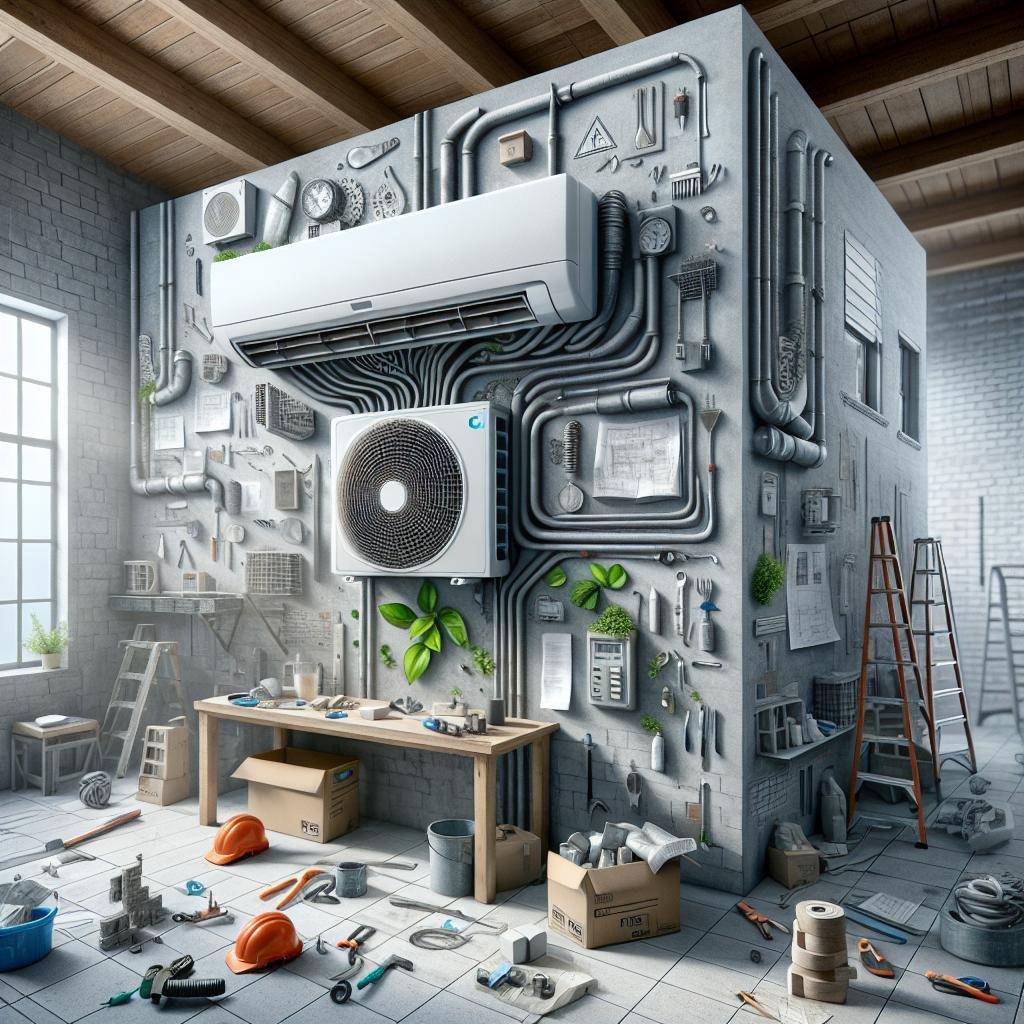As the landscape of commercial properties continues to evolve, so too does the need for efficient and adaptive climate control solutions. Whether revamping an aging space or reimagining a new one, property owners and managers face the challenge of integrating modern amenities into structures with diverse architectural quirks and limitations. Amidst these ongoing renovations, mini split air conditioning systems have emerged as a transformative solution, offering a blend of flexibility, efficiency, and minimal disruption. This article explores the myriad reasons why mini split AC units are ideally suited for retrofits and renovations in commercial properties, illuminating not just their practical benefits, but also their potential to enhance comfort and sustainability in every corner of the modern workspace.
Efficient Climate Control: How Mini Split Systems Enhance Comfort in Commercial Spaces
Mini split systems are rapidly becoming the go-to choice for commercial properties undergoing retrofits and renovations due to their remarkable flexibility and efficiency. These systems offer the advantage of targeted heating and cooling, allowing businesses to customize climate control for specific areas or zones. This precise temperature regulation not only enhances the overall comfort of the workspace but also contributes to significant energy savings, as units can operate independently based on occupancy and specific needs. Furthermore, their compact and modular design means they can be seamlessly integrated into existing spaces without the need for extensive ductwork, minimizing disruption during renovations.
In addition to their efficiency, mini split systems boast advanced features that can enhance the overall atmosphere within commercial environments. By employing inverter technology, these units adjust their operation based on real-time conditions, optimizing energy use while maintaining consistent comfort levels. Other key features include multi-zone capabilities, allowing for diverse climate preferences across different departments, and air filtration systems that improve indoor air quality. When evaluating the potential for mini split installation, consider the following benefits:
- Energy Efficiency: Lower operational costs through variable-speed compressor technology.
- Design Flexibility: Installation options that fit diverse architectural layouts and styles.
- Quiet Operation: Reduced noise levels, ideal for work environments requiring minimal disruption.

Seamless Integration: The Aesthetic and Functional Benefits of Mini Splits in Retrofits
When considering a retrofit for a commercial property, the aesthetic appeal of a building should not be overlooked. Mini-split systems are designed with sleek, contemporary features that can seamlessly blend with a variety of architectural styles, from vintage storefronts to modern office spaces. Their compact size allows for discreet installation, eliminating the need for bulky ductwork that can disrupt the original design elements. These units can be strategically placed to enhance the visual flow of the space while providing effective cooling and heating, ensuring that both form and function coexist harmoniously.
Moreover, mini-splits offer significant flexibility in terms of installation and functionality. Their zoned cooling capabilities allow for targeted temperature control in different areas of a building, making them an excellent choice for multi-use spaces. Property owners can enjoy a range of benefits, including:
- Energy Efficiency: Individual unit control reduces energy waste.
- Low Noise Levels: Advanced technology minimizes sound disruption.
- Easy Installation: Minimal disruption to existing structures and aesthetic elements.
- Quick Retrofit: Installation can often be completed in a single day.
By opting for a mini-split system, property owners gain a versatile solution that harmonizes with their vision for revitalized spaces while enhancing overall energy performance.

Cost-Effective Solutions: Energy Savings and Return on Investment with Mini Split AC
Minimizing energy costs while maximizing comfort is a top priority for commercial property owners looking to retrofit or renovate their spaces. Mini split AC systems stand out in this regard, offering high efficiency and flexibility that conventional HVAC systems struggle to match. These systems utilize inverter technology to precisely control temperature, which results in reduced power consumption. By avoiding the centralized approach, mini splits allow for targeted cooling or heating in occupied zones only, leading to significant energy savings over time. Additionally, their easy installation means minimal disruption during renovations, allowing businesses to maintain operations without excessive downtime.
To illustrate the potential return on investment, consider the following benefits:
- Reduced Energy Bills: Mini splits can save up to 30% compared to traditional units.
- Incentives and Rebates: Many regions offer financial incentives for installing energy-efficient systems.
- Enhanced Air Quality: With advanced filtration, mini splits contribute to healthier indoor environments.
- Scalability: Businesses can add units as needed, avoiding the costly installation of larger systems.
Here’s a simple overview of estimated savings over three years for a typical commercial space:
| Year | Energy Cost Savings | System Maintenance | Payback Period |
|---|---|---|---|
| 1 | $800 | $150 | — |
| 2 | $900 | $150 | — |
| 3 | $1,000 | $150 | — |
These insights illuminate the impressive long-term advantages of mini split AC systems, making them the go-to choice for modern commercial renovations where efficiency is paramount.

Flexible Installation: Overcoming Renovation Challenges with Versatile Mini Split Design
Renovating commercial properties often comes with a unique set of challenges, particularly when it comes to HVAC systems. Traditional ducted air conditioning may not fit within the existing structure or layout, leading to complications such as extensive renovations or prohibitive costs. Mini split systems provide a flexible solution, allowing for installation in tight or awkward spaces without the need for ductwork. This adaptability means that businesses can efficiently manage their air conditioning needs with minimal disruption to their ongoing operations.
The versatility of mini split designs ensures that they can be seamlessly integrated into various architectural styles and layouts. Some key advantages of mini splits include:
- Customized Installations: Units can be strategically placed to deliver maximum comfort in any room.
- Minimal Aesthetic Impact: Indoor units are sleek and compact, preserving the aesthetic integrity of the space.
- Zoning Capabilities: Individual control for different areas allows for optimal temperature management based on occupancy.
In addition to these benefits, the lack of ductwork reduces the complexity of the installation process, significantly cutting down renovation timelines and costs. As a result, mini split systems stand out as an ideal choice for retrofitting existing structures, paving the way for more energy-efficient and comfortable commercial environments.
Q&A
Q&A: Why Mini Split AC is Ideal for Retrofits and Renovations in Commercial Properties
Q: What is a mini split AC system, and how does it work?
A: A mini split AC system is a type of air conditioning that consists of an outdoor compressor and one or more indoor air handling units. These units are connected by refrigerant lines, allowing for flexible installation and zoning options. Unlike traditional HVAC systems, mini splits do not require ductwork, making them ideal for spaces undergoing renovations or retrofitting.
Q: Why are mini split systems particularly suitable for retrofits in commercial properties?
A: Mini split systems shine in retrofit scenarios because they require minimal structural modifications. Without the need for extensive ductwork, they can often be installed in existing spaces with minimal disruption to business operations. This flexibility allows property owners to upgrade their cooling systems quickly and efficiently, improving comfort without the headaches of traditional installation processes.
Q: How do mini splits improve energy efficiency in renovated commercial spaces?
A: Mini split systems are known for their superior energy efficiency, thanks to their inverter technology and programmable settings. They can cool or heat specific zones based on occupancy, minimizing wasted energy in unoccupied rooms. For renovated properties, this means lower utility bills and a reduced carbon footprint, aligning operational costs with sustainability goals.
Q: Can mini split AC systems easily adapt to different commercial property layouts?
A: Absolutely! Mini split systems are highly modular, allowing for one outdoor unit to support multiple indoor units in different configurations. This adaptability makes them an excellent choice for diverse commercial layouts, whether you’re dealing with open floor plans, multi-story buildings, or distinct departments within a larger facility.
Q: Are there any aesthetic considerations with mini split installations in commercial properties?
A: Yes, aesthetic considerations matter, especially in commercial spaces that prioritize design. Mini splits offer sleek, modern indoor units that can blend seamlessly into various decors. Additionally, their compact size allows for less intrusive placement, reducing their visual impact while maintaining functionality.
Q: What about maintenance? Is it easy to care for a mini split system?
A: Maintenance of a mini split system is generally straightforward. With regular upkeep, such as cleaning filters and checking refrigerant levels, these systems can operate efficiently for years. Additionally, since there are no ducts to clean, maintenance schedules can be simplified, making it easier for property managers to ensure reliable comfort without excessive downtime.
Q: Are there any drawbacks to using mini split AC systems in commercial renovations?
A: While mini splits offer numerous advantages, they may have certain drawbacks. The initial cost can be higher than conventional AC systems, especially if multiple indoor units are necessary for larger spaces. Additionally, some property owners may need to manage the aesthetics of the outdoor unit installation. Nonetheless, many find the energy savings and flexibility worth the investment in the long run.
Q: What should property owners consider when deciding on mini split systems for their renovations?
A: Property owners should evaluate the specific needs of their space, including layout, desired cooling capacity, and energy efficiency goals. Consulting with HVAC professionals is also crucial to ensure that the selected system is adequately sized and installed according to local codes and regulations. thorough planning will help maximize the benefits of mini split AC systems in renovated commercial properties.
Q: Is there a specific type of commercial property that benefits most from mini split installations?
A: Mini split AC systems are particularly beneficial for mixed-use buildings, older structures, and spaces with irregular layouts. They are also ideal for environments requiring distinct temperature zones, such as offices, retail spaces, or dining establishments. Ultimately, properties undergoing renovations stand to gain significantly from the versatility and efficiency of mini split systems.
Insights and Conclusions
as the demands of modern commercial spaces continue to evolve, so too must our approaches to climate control. Mini split AC systems emerge as a cutting-edge solution for retrofit and renovation projects, seamlessly blending efficiency with flexibility. Their compact design not only conserves valuable real estate but also promotes optimal comfort without the disruptive renovations associated with traditional ducted systems. With their ability to provide tailored temperature solutions for diverse environments, mini splits empower property owners and managers to enhance existing spaces while ensuring energy efficiency and occupant satisfaction. As we embrace the future of sustainable building practices, mini split AC technology stands as a testament to innovation and adaptability in the ever-changing landscape of commercial properties. As you embark on your next renovation journey, consider the advantages of mini splits—where comfort meets convenience, and transformation is just one installation away.

